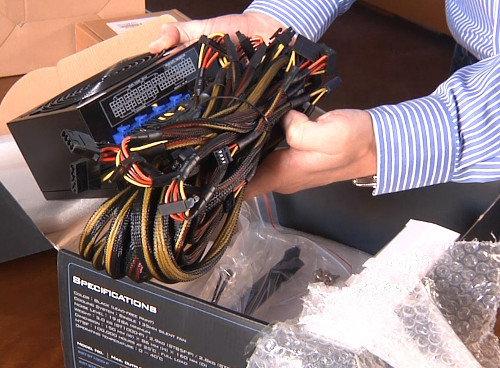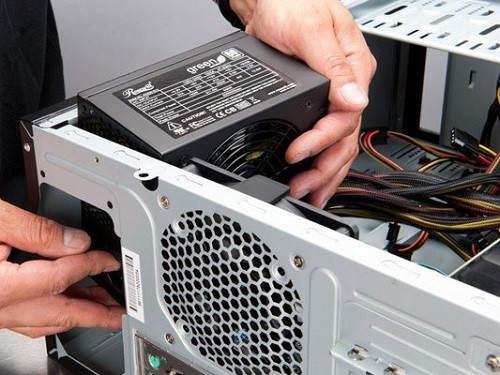5 things to know when buying computer power supplies
You need to consider to choose the right capacity according to your needs, choose the model that uses energy efficient according to the 80 Plus standard, do not buy cheap products from less famous brands.
When building a new desktop system, most users pay less attention to an equally important component, which is the power supply (PSU). Normally, everyone wants to spend most of the cost on the main components of the computer such as motherboard, processor (CPU), memory (RAM) and storage drive (HDD or SSD). .
In addition, for graphic designers or gamers, adding a large sum of money to a new generation graphics card seems more reasonable than investing in a genuine power supply. However, tests show that the power supply also plays an important role more or less in computer performance. That is where power supply for the entire system. Therefore, please refer to the considerations below before choosing to purchase an effective power supply for your computer system.
How much capacity do you need?
Manufacturers often list their power source product capacity in Watt units (W). A higher wattage power supply can provide more power, meeting the need for more components for the system. On the market today, desktop power has a capacity of about 400W up to 1.800W. These numbers are continuous power, not peak power. Note that most power supplies can only operate at peak power for a short period of time.
 The power level of the system should be determined to choose the appropriate power supply .
The power level of the system should be determined to choose the appropriate power supply .
When planning to assemble a new computer, you can calculate the power consumption of the component components and then select the appropriate power source. Usually, you can calculate the excess compared to the expected number to prevent future upgrades. For users who only need basic work, it is enough to have a medium configuration computer with a power supply of about 400W. But for users who are passionate about technology, like "dabble", they should choose a large power source to meet the demand of overclocking, add more lights or decorative toys for the chassis, water radiator installed in, .
Continuous power or peak power?
Currently, the power values printed on the power supply sticker are usually two forms, including peak power (Peak Wattage) and continuous power (Continuous Wattage). The peak power capacity is the maximum power (Maximum Wattage) that the power supply can meet in a certain period of time; while continuous power is the effective power (Total Wattage), which is the power level at which the power supply can operate safely continuously.
Continuous capacity and peak power are usually published based on manufacturer tests. For example, a power supply with a continuous power of 500W and that indicates that it can provide 500W output power continuously without fluctuation. Meanwhile, if published with a peak power of 500W, the power supply can only provide a maximum power of 500W, but perhaps only in a few minutes before falling to a lower level. For simplicity, ordinary computer users should only care about the continuous power level when choosing to buy the power supply and ignore the peak power parameters.
Effective use of electricity
Technically, the computer power supply takes AC power from the main power outlet and converts it into DC current. Then, the power is transmitted to all hardware components inside the machine connected to the power supply. However, power supplies often lose some of the power during the conversion process. Therefore, an efficient power supply is the power supply that manages the level of power it can convert and how less is lost. Another advantage of efficient power supplies is that they generate less heat during operation and are generally quieter.
 The 80 Plus hierarchy indicates the ability to keep electrical efficiency at load levels .
The 80 Plus hierarchy indicates the ability to keep electrical efficiency at load levels .
In the past few years, you've probably heard of 80 Plus standards for computer power supplies. Basically, 80 Plus certification is used to classify power supplies according to the ability to keep at least 80% efficiency at 25%, 50%, 75% and 100% loads. The 80 Plus system is increasingly being favored by manufacturers, starting with Bronze, Silver, Gold levels, and then adding Platinum and Titanium . Before the 80 Plus hierarchy came into being, power supply prices were often determined primarily by capacity. At present, level 80 Plus is equally important in determining the price of a power supply.
Why not choose a cheap source?
Similar to choosing to buy any product, we should buy a quality computer source from well-known brands instead of choosing low-cost power models from lesser-known brands. As mentioned from the beginning, the power supply affects every part of the computer system and can cause damage to any component in the event of power fluctuations.
Good power supplies must provide "standard" current for components. In other words, the problem of current stability must be placed on top. Choosing the right source will bring stability and long life to the entire system. Therefore, you should consider carefully when seeing a source with a high capacity announced but the price is too cheap. Quality is always proportional to cost, which is why you should choose products from reputable manufacturers. Big brands often launch a wide variety of products, rich in designs and features for users to choose in accordance with their needs.
See product reviews
Just like when choosing to buy other components, you should also consult your friends, from computer savvy people or online information sources about the parameters of the source that you plan to buy, also such as reading introductions and product reviews before making a decision. Manufacturers often release new power supply models at a rapid rate and on their home page often have product reviews for users to consider. Some famous and reputable brands in the field of computer resources that you can refer to are Master, Corsair, Antec, Acbel, Thermaltake .
 Power supply is an equally important component inside the computer.
Power supply is an equally important component inside the computer.
In addition, some well-known technology sites such as Tom's Hardware, AnandTech or JohnnyGuru often have in-depth reviews of computer power supply products. Besides, under these articles there are often many people who understand computer hardware comment to share more information and their own experience. This is the place for you to thoroughly understand the product before making the right decision to choose to buy the computer power supply that suits your needs.
You should read it
- Computer power source: More important than you think
- 4 things to note before choosing to buy a PSU power supply for a PC
- How to Check a Power Supply
- How to Test a PC Power Supply
- Computer source: Things to know
- 8 best PSUs of 2019
- When the power goes out, how long will the computer turn off?
- Choosing a case and a power supply for a computer
- How to assemble an ATX power supply for a computer
- How to Run Your Desktop off DC Power
- Gigabyte reveals first PCIe Gen5 compatible power supply information
- How to manually check the computer source with a multimeter
May be interested

Instructions to fix Windows error does not boot

Create Windows Password Reset Disk on Windows 7 with USB Flash Drive

Steps to fix errors: 'Windows Protection Resource cannot start the repair service'

Summary of common errors on Bluestacks and how to fix each error

Instructions on how to upgrade RAM on computers and Laptops

Reset Notepad to the initial default setting state






 Instructions on how to plug in the computer power cord correctly and quickly
Instructions on how to plug in the computer power cord correctly and quickly Things to keep in mind when buying a used computer
Things to keep in mind when buying a used computer 4 things to note before choosing to buy a PSU power supply for a PC
4 things to note before choosing to buy a PSU power supply for a PC Things to do after buying a new computer
Things to do after buying a new computer 6 things to consider before buying a PS5
6 things to consider before buying a PS5 Computer internal parts
Computer internal parts